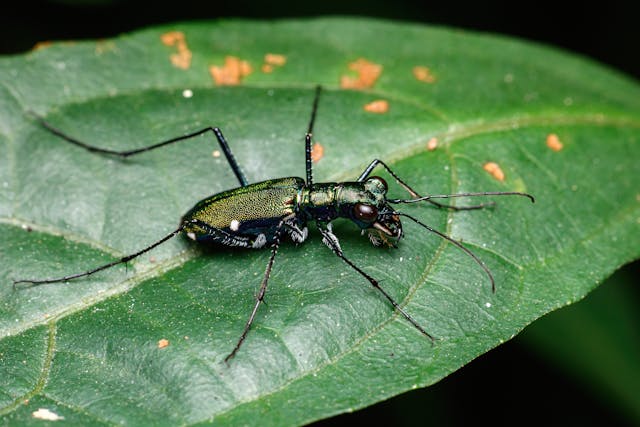
What is the fastest insect? The fastest flying insect is the dragonfly and the fastest running insect is the Australian tiger beetle.
The Australian tiger beetle is the fastest insect on land. It can run at 2.5 m per second, which works out to 9 km/h. That doesn’t sound terribly fast and most of us could probably beat one in a race if we wanted to, but you have to bear in mind that they are only 2 cm long. When we are sprinting, we probably take paces that are 1.5 m long and most of us can probably do 5 or more meters per second. Usain Bolt peaks at 12.4 m per second, which is far faster than the Australian tiger beetle. However, Usain Bolt is 195 cm tall (6 foot 4) and the Australian tiger beetle is 2 cm long. That means, at top speed, to run 2.5 m per second, the beetle is covering 125 body lengths a second. If Usain Bolt could do that, he would be covering 243 m every second, which is a speed of 877.5 km/h. I think that if Usain Bolt could run at close to 900 km/h, his bones would disintegrate and his limbs would all come off. That doesn’t happen to the beetle.
Tiger beetles have very long legs that can move extremely quickly, carrying them across the ground at speed. They actually move so fast that after a short while, they can no longer see the prey they are chasing. Insect compound eyes are basically a collection of light sensors that can only detect light if it hits them at a certain angle. When the tiger beetle chases its prey, it reaches such a speed that the angle of the light from the prey is too much for it to reach the beetle’s eye, which means the beetle can’t see what it is chasing. It fixes on the location of the prey, runs at it, then stops to reorient itself and runs on again. They have antennae which they can use to sense their surroundings and make sure they don’t run into anything.
The fastest flying insect is the dragonfly. They have been clocked at 56 km/h. That puts them slightly faster than the hawk moth which can reach 54 km/h. Those are both very fast for their size. Dragonflies are not just fast, they are incredibly agile, possibly the most agile of all the insects and the reason for their speed and their agility is the construction of their wings. In the insect world there are two different ways that wings can be attached and flapped. The most common way is where the wings are attached to the thorax of the insect. Muscles inside the thorax pull on it and warp its shape, pulling the wings down. When the muscle relaxes, the thorax springs back into its original form and the wings point up. This elastic energy fuels the next pull of the muscles, which flaps the wings again. Some insects can use this method to flap their wings over a thousand times a second. Because of the elasticity in their exoskeleton, the wings are almost bouncing up and down. The only two insects that don’t use this system are dragonflies and mayflies, and they have a system where their wings are joined directly to muscles. They flap their muscles by contracting and relaxing these flight muscles. They can only flap their wings as fast as they can send signals to their muscles, which is about thirty times a second, but it gives them far more control over their wings than flies will ever have.
Dragonflies have four wings and because the wings are not connected to their thorax, they can rotate them independently. This allows them to make very quick and sudden turns because they can angle one or two wings into the air and turn almost like a rowing boat will when one oar is jammed in the water. This ability also means they can fly much faster than other insects despite only being able to flap thirty times a second. They can angle their wings to get more lift and more thrust when they need a sudden burst of speed. They have evolved to be so fast and so maneuverable because they feed on mosquitos, which are incredibly fast themselves. If you see dragonflies whizzing through the air, they are eating all the mosquitoes. And this is what I learned today.
Photo by cassius cardoso: https://www.pexels.com/photo/tiger-beetle-sitting-on-a-leaf-25961583/
Sources
https://askabiologist.asu.edu/tiger-beetle-adaptations
https://news.cornell.edu/stories/1998/01/tiger-beetles-go-blind-chasing-prey-high-speeds
https://entomology.unl.edu/scilit/fastest-runner-0
https://www.discoverwildlife.com/animal-facts/insects-invertebrates/fastest-insect
https://en.wikipedia.org/wiki/Tiger_beetle
https://asknature.org/strategy/wing-structure-allows-rapid-acceleration
